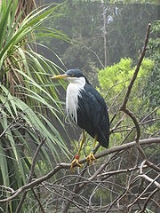
Pied Heron
Encyclopedia
The Pied Heron also known as the Pied Egret is a bird found in coastal and subcoastal areas of monsoon
al northern Australia as well as some parts of Wallacea
and New Guinea
.
was originally described by ornithologist John Gould
in 1845. Some taxonomists put this species in the genus Egretta
. There are no recognised subspecies
.
, 43–55 cm long, with dark slaty wings, body, and crested head, with a white throat and neck. The appearance is similar to the White-necked Heron
. Males (247–280 g) are heavier than females (225–242 g), but the two are similar in appearance.
Immature birds lack the crest as well as the dark colouring on the head and may look like small versions of the White-necked Heron
. The juveniles were once classified as a separate species.
s and wet grassland
s.
s, often colonially
with other species of heron. 1–2 blue-green eggs are laid in a shallow platform of sticks.
Monsoon
Monsoon is traditionally defined as a seasonal reversing wind accompanied by corresponding changes in precipitation, but is now used to describe seasonal changes in atmospheric circulation and precipitation associated with the asymmetric heating of land and sea...
al northern Australia as well as some parts of Wallacea
Wallacea
Wallacea is a biogeographical designation for a group of Indonesian islands separated by deep water straits from the Asian and Australian continental shelves. Wallacea includes Sulawesi, the largest island in the group, as well as Lombok, Sumbawa, Flores, Sumba, Timor, Halmahera, Buru, Seram, and...
and New Guinea
New Guinea
New Guinea is the world's second largest island, after Greenland, covering a land area of 786,000 km2. Located in the southwest Pacific Ocean, it lies geographically to the east of the Malay Archipelago, with which it is sometimes included as part of a greater Indo-Australian Archipelago...
.
Taxonomy
The speciesSpecies
In biology, a species is one of the basic units of biological classification and a taxonomic rank. A species is often defined as a group of organisms capable of interbreeding and producing fertile offspring. While in many cases this definition is adequate, more precise or differing measures are...
was originally described by ornithologist John Gould
John Gould
John Gould was an English ornithologist and bird artist. The Gould League in Australia was named after him. His identification of the birds now nicknamed "Darwin's finches" played a role in the inception of Darwin's theory of evolution by natural selection...
in 1845. Some taxonomists put this species in the genus Egretta
Egretta
Egretta is a genus of medium-sized herons, mostly breeding in warmer climates. Representatives of this family are found in most of the world, and the Little Egret, as well as being widespread throughout much of the Old World, has now started to colonise the Americas.These are typical egrets in...
. There are no recognised subspecies
Subspecies
Subspecies in biological classification, is either a taxonomic rank subordinate to species, ora taxonomic unit in that rank . A subspecies cannot be recognized in isolation: a species will either be recognized as having no subspecies at all or two or more, never just one...
.
Description
It is a small heronHeron
The herons are long-legged freshwater and coastal birds in the family Ardeidae. There are 64 recognised species in this family. Some are called "egrets" or "bitterns" instead of "heron"....
, 43–55 cm long, with dark slaty wings, body, and crested head, with a white throat and neck. The appearance is similar to the White-necked Heron
White-necked Heron
The White-necked Heron, Ardea pacifica also known as the Pacific Heron is found throughout New Guinea and Australia, except for the most arid regions, and is a vagrant to New Zealand....
. Males (247–280 g) are heavier than females (225–242 g), but the two are similar in appearance.
Immature birds lack the crest as well as the dark colouring on the head and may look like small versions of the White-necked Heron
White-necked Heron
The White-necked Heron, Ardea pacifica also known as the Pacific Heron is found throughout New Guinea and Australia, except for the most arid regions, and is a vagrant to New Zealand....
. The juveniles were once classified as a separate species.
Distribution and habitat
Its habitat mainly comprises a range of wetlandWetland
A wetland is an area of land whose soil is saturated with water either permanently or seasonally. Wetlands are categorised by their characteristic vegetation, which is adapted to these unique soil conditions....
s and wet grassland
Grassland
Grasslands are areas where the vegetation is dominated by grasses and other herbaceous plants . However, sedge and rush families can also be found. Grasslands occur naturally on all continents except Antarctica...
s.
Call
The call of the Pied Heron is a loud 'awk' or 'ohrk' in flight. Soft cooing is given around the nest. Little else is known about vocalisations.Breeding
Breeding takes place from February to May. It nests in trees above the water, including mangroveMangrove
Mangroves are various kinds of trees up to medium height and shrubs that grow in saline coastal sediment habitats in the tropics and subtropics – mainly between latitudes N and S...
s, often colonially
Bird colony
A bird colony is a large congregation of individuals of one or more species of bird that nest or roost in close proximity at a particular location. Many kinds of birds are known to congregate in groups of varying size; a congregation of nesting birds is called a breeding colony...
with other species of heron. 1–2 blue-green eggs are laid in a shallow platform of sticks.

